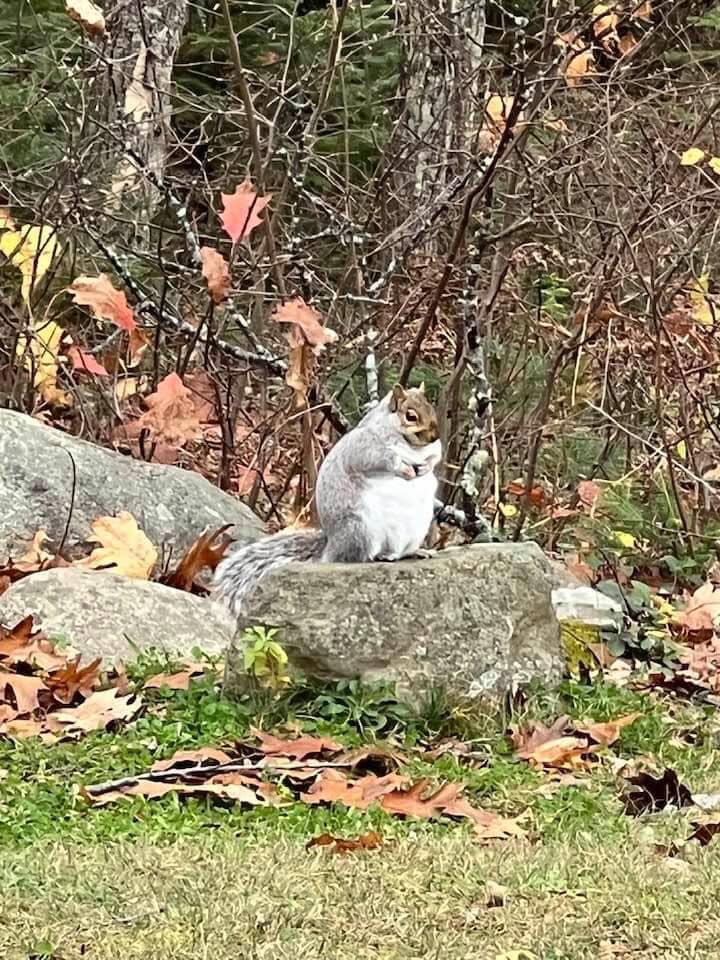
‘Squirrelzilla’ proves Maine’s gray squirrels are fat and fluffy this fall
By Julia Bayly, Bangor Daily News Staff
They call it “Squirrelzilla.”
The gray squirrel rules supreme in a southern Maine homeowner’s yard, scampering up exterior walls and terrorizing the household dog.
He is, in a word, chonky. Really, really chonky.
Chonky, chunky, big-boned and rotund. That’s how people around the state are describing gray squirrels this season, which seem to be larger than in years past. Folks have been swapping photos of the super-sized rodents on social media, claiming to have the most robust of them all in their yards.
Based on her photos, Beth Ditkoff of Damariscotta may be able to claim that distinction. She has a squirrel so large that the support posts on her deck rails are not large enough for him to hide behind.
“I’m looking at him right now because he’s watching me through the glass door,” Ditkoff said during a phone interview Tuesday morning. “We have this deck and we are used to seeing squirrels scampering around, but there is no scampering anymore.”

SQUIRRELZILLA – Homeowners around Maine are reporting gray squirrels are much larger and well fed looking this season. This fellow is a regular at a feeder in Damariscotta.
Rather, Ditkoff and others are saying the squirrels are lumbering, waddling or plodding their way over lawns and to bird feeders in search of their next meal.
Some squirrels have figured out how to unlatch feeders to release seeds directly onto the ground. Others simply gorge in the feeder, take a nap among the seeds and wake up to gorge again.
One woman said she has a rotund squirrel who has left dozens of tiny paw prints on her glass door from the times it knocks to remind her the feeder is empty.
According to Shevenell Webb, furbearer biologist with the Maine Department of Inland Fisheries and Wildlife, wild foods on which squirrels and other rodents rely, were somewhat plentiful this summer and that could account for the number of larger than normal animals people are seeing.
“Although it can be variable by location, it has been a decent mast year in Maine,” Webb said.
“Acorns, beechnuts and hazelnuts are a few of the many nuts that wildlife rely on to pack on the extra calories needed to survive a Maine winter.”
Extended periods of wet, humid weather in the state provided another food source for the squirrels.
“I also noticed it has been a banner fall with an abundance of different types of mushrooms, which squirrels also enjoy,” Webb said.
Jennifer Clements is a registered nurse at a Greenville care facility. She said the resident gray squirrel there — dubbed Godzilla — has learned to let the smaller red squirrels do most of the work.
“He is a surprisingly huge gray squirrel and he just keeps getting bigger,” Clements said. “He can’t fit into the feeder, so he waits for the smaller red squirrels to make a mess spilling seeds onto the ground and eats those.”
Squirrels do fatten up for the winter, Webb said, but their size can also be attributed to healthy, fluffy coats of fur.
Though they do slow down in the winter, they are not true hibernators. Rather, they tend to stay in their nests during the colder periods and venture out when things warm up a bit.
Watching Maine wildlife is one of the perks of living in the state, but Webb does urge caution when it comes to attracting them to your house.
“Supplemental feeding increases the number of individuals coming into contact with each other, which can increase the transmission of diseases,” she said. “Planting native plants on your property, like oak trees, is a great way to enjoy and keep our wildlife healthy in the long run.”